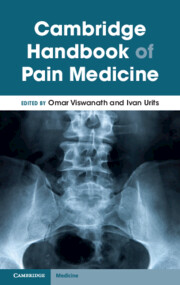Book contents
- Cambridge Handbook of Pain Medicine
- Cambridge Handbook of Pain Medicine
- Copyright page
- Contents
- Contributors
- Pain Handbook Introduction
- Part I Introduction to Pain: Pain Signaling Pathways
- Part II Common Categories of Pharmacologic Medications to Treat Chronic Pain
- Chapter 4 Nonsteroidal Anti-inflammatory Drugs (NSAIDs)
- Chapter 5 Acetaminophen
- Chapter 6 Topicals
- Chapter 7 Muscle Relaxants
- Chapter 8 Opioids
- Chapter 9 Antineuropathic Medications
- Chapter 10 Cannabinoids
- Part III Chronic Pain Conditions Head and Neck
- Part IV Spine
- Part V Extremities
- Part VI Misc
- Part VII Adjunctive Therapy
- Index
- References
Chapter 4 - Nonsteroidal Anti-inflammatory Drugs (NSAIDs)
from Part II - Common Categories of Pharmacologic Medications to Treat Chronic Pain
Published online by Cambridge University Press: 01 December 2023
- Cambridge Handbook of Pain Medicine
- Cambridge Handbook of Pain Medicine
- Copyright page
- Contents
- Contributors
- Pain Handbook Introduction
- Part I Introduction to Pain: Pain Signaling Pathways
- Part II Common Categories of Pharmacologic Medications to Treat Chronic Pain
- Chapter 4 Nonsteroidal Anti-inflammatory Drugs (NSAIDs)
- Chapter 5 Acetaminophen
- Chapter 6 Topicals
- Chapter 7 Muscle Relaxants
- Chapter 8 Opioids
- Chapter 9 Antineuropathic Medications
- Chapter 10 Cannabinoids
- Part III Chronic Pain Conditions Head and Neck
- Part IV Spine
- Part V Extremities
- Part VI Misc
- Part VII Adjunctive Therapy
- Index
- References
Summary
Ibuprofen and naproxen are nonsteroidal anti-inflammatory drugs (NSAIDs) that work by inhibiting cyclooxygenase (COX) 1 and 2, enzymes involved in the synthesis of prostaglandins that contribute to pain, inflammation, and fever. Therefore, cyclooxygenase modulation contributes to the anti- inflammatory and analgesic qualities of ibuprofen and naproxen. While NSAIDs have been shown to be effective in the treatment of chronic low back pain, they can also have adverse effects on the gastrointestinal, renal, and coagulation systems, including gastric pain, vomiting, bleeding, gastric ulcers, acute renal failure, interstitial nephritis, and nephritic syndrome. Long-term use of NSAIDs increases the risk of such side effects. While short-term use is considered relatively safe, the evidence for the long-term efficacy of NSAIDs for chronic low back pain is limited, and the ACP recommends them as a first-line pharmacological agent with caution. The use of NSAIDs, especially over a prolonged time, is also not without risk. Long term use predisposes patients to considerable side effects.
- Type
- Chapter
- Information
- Cambridge Handbook of Pain Medicine , pp. 39 - 43Publisher: Cambridge University PressPrint publication year: 2023



